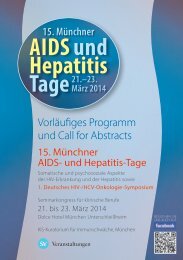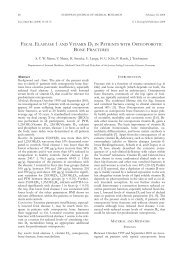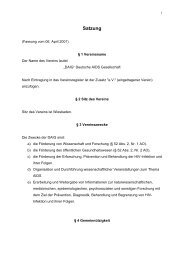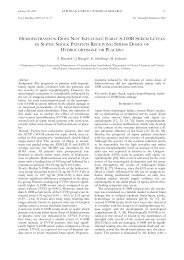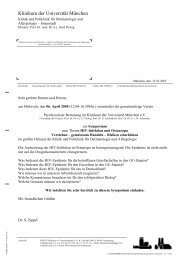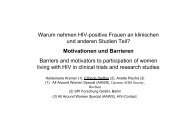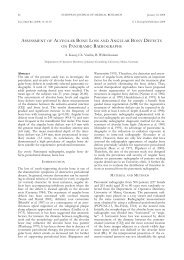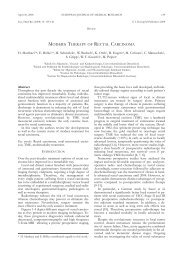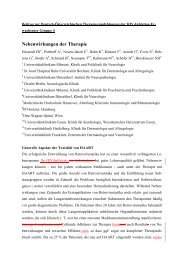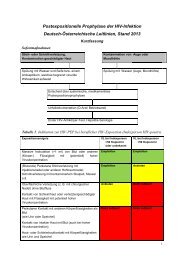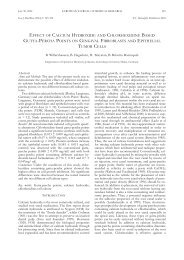European Journal of Medical Research - Deutsche AIDS ...
European Journal of Medical Research - Deutsche AIDS ...
European Journal of Medical Research - Deutsche AIDS ...
You also want an ePaper? Increase the reach of your titles
YUMPU automatically turns print PDFs into web optimized ePapers that Google loves.
74 EUROPEAN JOURNAL OF MEDICAL RESEARCH<br />
June 27, 2007<br />
C.10 (Poster)<br />
Risk factors for hepatitis C in HIV positive MSM.<br />
A preliminary evaluation <strong>of</strong> a case control study<br />
Schmidt A.J. 1 , Vogel M. 2 , Rockstroh J.K. 2 , Radun D. 1 ,<br />
Study Group on Sexual Risk Factors for Hepatitis C<br />
1 Robert Koch-Institut, Infektionsepidemiologie, Berlin,<br />
Germany, 2 Universitätsklinikum Bonn, Medizinische Klinik<br />
und Poliklinik I, Bonn, Germany<br />
Objectives: Since 2001, clinicians in Europe have been reporting<br />
increasing numbers <strong>of</strong> infections with the hepatitis C virus<br />
(HCV) in HIV positive men who have sex with men (MSM).<br />
The possible routes <strong>of</strong> HCV transmission are still uncertain and<br />
controversial. Despite biological plausibility, major longitudinal<br />
studies in HIV negative MSM showed no evidence for an<br />
epidemiologically relevant sexual transmission. Therefore, the<br />
aim <strong>of</strong> this study is to explore social, behavioural/sexual, or<br />
nosocomial risk factors for hepatitis C in HIV positive MSM.<br />
Methods: In 2006, we conducted a case control study embedded<br />
in a survey on knowledge, attitudes and behaviour in German<br />
MSM as to sexually transmitted infections. Cases consisted<br />
<strong>of</strong> HIV positive MSM with known HCV infection and<br />
no history <strong>of</strong> injecting drug use (IDU), as IDU and related<br />
sharing <strong>of</strong> equipment is the leading risk factor for HCV infection<br />
in industrialised countries. HIV positive MSM without<br />
known HCV infection, matched for age group, served as controls.<br />
The HCV serostatus <strong>of</strong> controls was confirmed by an<br />
anti-HCV-antibody test from dried blot spots.<br />
Results: So far, 22 cases and 44 controls were included for<br />
preliminary evaluation. In the bivariate analysis, significant<br />
risk factors were<br />
(1)consumption <strong>of</strong> nasally applicable drugs like cocaine<br />
(OR=10.5; 95%CI:2.2-50.8),<br />
(2)history <strong>of</strong> major surgery (OR=9.1; 95%CI:1.7-48.9),<br />
(3)“gangbanging” or group sex (OR=7.7; 95%CI: 2.0-29.1),<br />
(4)a history <strong>of</strong> more than 5 episodes <strong>of</strong> unprotected anal intercourse<br />
within the last 12 months (OR=7.5; 95%CI:2.1-26.2),<br />
(5)bleeding anal injuries from any sort <strong>of</strong> sexual intercourse<br />
(OR=7.13; 95%CI:1.3-39.1),<br />
(6)“fisting” (OR=5.9; 95%CI:1.4-25.9), or<br />
(7)use <strong>of</strong> sildenafil (OR=4.1; 95%CI:1.3-13.0).<br />
In logistic regression, (1) and (5) remained in the model<br />
(OR=13.2; 95%CI: 2.3-74.9 and OR=7,7; 95%CI:1.0-60.3).<br />
Conclusion: There is evidence that in HIV positive MSM, a<br />
complex interaction between certain sexual practices and associated<br />
behaviour like consumption <strong>of</strong> cocaine are relevant risk<br />
factors for HCV transmission. However, a history <strong>of</strong> major<br />
surgery might be a non-sexual risk factor, and clinical studies<br />
should be implemented to further focus on nosocomial risks.<br />
More cases and controls are needed to fit adequate power.<br />
C.11 (Vortrag)<br />
Investigation <strong>of</strong> CD4+ T cell apoptosis rates in<br />
HIV- and HIV/HCV-coinfected patients treated<br />
with a highly active anti-retroviral therapy<br />
(HAART)<br />
Körner C. 1 , Schulte D. 1 , Nischalke H.-D. 1 , Nattermann J. 1 ,<br />
Spengler U. 1 , Rockstroh J. 1<br />
1 Universitätsklinikum Bonn, Medizinische Klinik 1, Bonn, Germany<br />
Objective: Hepatis C virus-coinfection accelerates the progression<br />
<strong>of</strong> HIV in infected patients. HIV-monoinfection has<br />
been suggested to be associated with an increased apoptosis<br />
rate. However it remained unclear how HCV-coinfection and<br />
HAART affects parameters <strong>of</strong> apoptosis. Therefore, we studied<br />
the level <strong>of</strong> apoptosis <strong>of</strong> CD4+ T cells in HIV-positive<br />
subjects with HCV-coinfection.<br />
Methods: For this study we selected HIV-monoinfected and<br />
HIV/HCV-coinfected patients who were either treated with<br />
HAART or not. Apoptosis rates <strong>of</strong> CD4+ T cells was performed<br />
with isolated PBMCs by detection <strong>of</strong> apoptosis-specific<br />
markers, such as DNA-fragmentation, expression <strong>of</strong> mitochondrial<br />
membrane protein APO2.7 and cleavage <strong>of</strong> poly-<br />
(ADP-ribose)-polymerase (PARP). Isolated PBMCs were also<br />
used to study terminal deoxynucleotidyl-transferase dUTP<br />
nick end labeling (TUNEL) in CD4+ T cells.<br />
Results: We found that treatment-naiv HIV-infected patients<br />
were associated with higher rates <strong>of</strong> apoptosis [n=4; 1.48%<br />
(percentage <strong>of</strong> APO2.7-positive CD4+ T cells shown)] as<br />
compared to healthy subjects (n=4; 0.65%). In HIV-monoinfection,<br />
effective HAART was associated with a reduction <strong>of</strong><br />
CD4+ T cell apoptosis (n=8; 1.01%), although apoptosis rates<br />
remained still higher than in healthy subjects. In contrast<br />
apoptosis levels remained elevated in patients who did not respond<br />
to HAART (n=4; 3.96%). Of note, CD4+ T lymphocytes<br />
<strong>of</strong> HCV/HIV-coinfected patients receiving effective<br />
HAART (n=3; 2.08%) displayed a markedly higher apoptosis<br />
rate than the treated HIV-monoinfected patients.<br />
Conclusions: Results suggest that loss <strong>of</strong> CD4+ T cells is associated<br />
with increased apoptosis and effective HAART correlates<br />
with CD4+ T cell recovery and reduced rates <strong>of</strong> CD4+<br />
T cell apoptosis. Elevated rates <strong>of</strong> apoptosis in HIV/HCVcoinfected<br />
patients despite effective HAART indicates increased<br />
CD4+ T cell turnover in this special subgroup.<br />
C.12 (Poster)<br />
GBV-C coinfection in HIV-1 infected patients<br />
influences phenotypic characteristics <strong>of</strong><br />
plasmacytoid dendritic cells<br />
Bhatnagar N. 1 , Moenkemeyer M. 1 , Hong H. 1 ,<br />
Schmidt R.E. 1 , Heiken H. 1<br />
1 Medizinische Hochschule Hannover, Klinische Immunologie<br />
K14, Hannover, Germany<br />
Objective: Improved survival rate <strong>of</strong> HIV-1 patients co-infected<br />
with the GB virus C (GBV-C, formerly known as hepatitis<br />
G virus) has been shown previously. These patients<br />
have lower viral load and higher CD4 counts. The mechanisms<br />
underlying this favourable effect are still not understood.<br />
Plasmacytoid dendritic cells (pDCs) are the main producers<br />
<strong>of</strong> IFN-a and also stimulate T cells in response to viral<br />
infection. Defective pDC number and function reported in<br />
HIV-1 infection can be restored by antiretroviral therapy. We<br />
investigated the role <strong>of</strong> pDCs in the beneficial effect <strong>of</strong> GBV-<br />
C in HIV-1 infected patients.<br />
Methods: Freshly isolated or CpG stimulated PBMCs were<br />
analysed by multicolor flow cytometry. Frequency and phenotype<br />
<strong>of</strong> pDCs were determined by gating on lin- CD123+<br />
BDCA-4+ cells.<br />
Results: Both the absolute numbers and percentage <strong>of</strong> pDCs<br />
in the peripheral blood were comparable in GBV-C coinfected<br />
and uninfected HIV-1 patients. However, the percentage <strong>of</strong><br />
pDCs expressing CD40 and CD83 was significantly higher in<br />
GBV-C coinfected compared to uninfected HIV-1 patients:<br />
8.2 ± 1.75% (n=7 GBV-C+) vs. 1.13% ± 0.256% (n=7 GBV-



